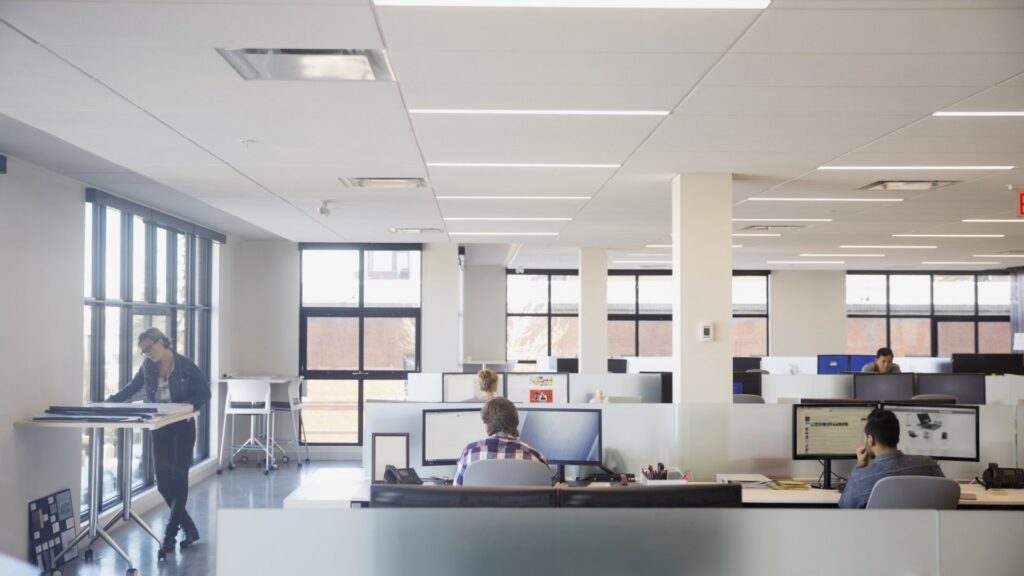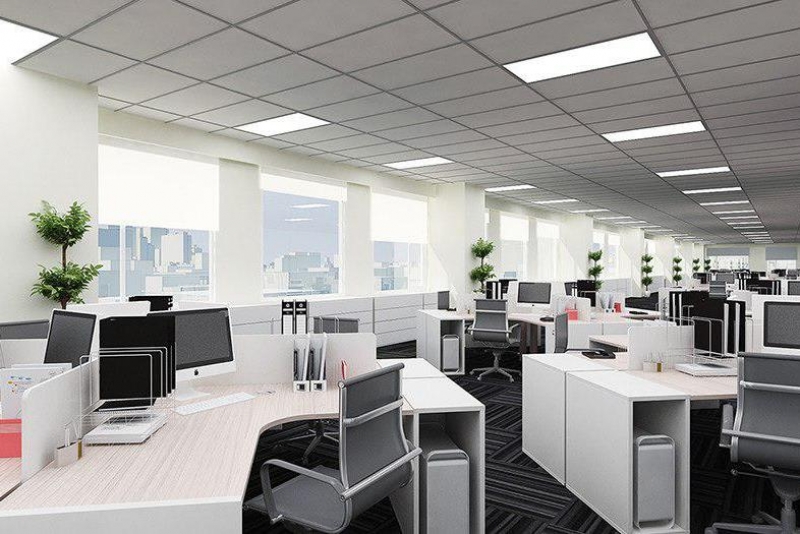Just like getting dressed, there are things you should consider before you choose an office space. Your office space should reflect your business identity and make a good first impression while being as productive as possible.
This article will explore the different factors to consider before choosing an office space, the types of offices, and the different layouts to consider.
Factors To Consider Before You Choose An Office Space

So you just set up your team and want to bring them together in a place to foster connection and teamwork; what should you consider before choosing an office space?
Here are the best things to consider:
1. Nature of your business
When choosing an office space, always consider the nature of your business and its industry. Start by asking what kind of office will reflect what you do. For instance, if you’re a goods delivery business, a downstairs location is most suitable to make it easier to move goods in and out.
You can’t consider the same thing with a service business that can fit in anywhere. Also, a shared office building is suitable for more visibility if you’re still a startup and don’t want to isolate yourself from other businesses in your industry.
When you consider your business location, you can then move on to finding the best location.
2. Location
Location is one of the first things to consider to choose an office space, as it is a foundation for all other essential factors.
Always consider the following:
- If people can quickly discover your business
- If the location is safe
- If it’s accessible by public transport
- If there is electricity and other basic amenities like an internet connection
- If there is an available parking spot
- If you’re close to your suppliers
You should choose an office location close to your company’s facilities. This will vary from company to company. The ideal location is as close to your clients as possible, and it’s vital to be close to your suppliers and business partners.
3. Competitors
Before you choose an office space, check where your competitors are. It’s crucial to achieve the correct balance when it comes to competition in any firm.
A specific customer segment may be lost if you are too far from your competitors, yet being too close to them may increase business pressure and rivalry.
4. Rental or acquisition cost
You should decide whether renting or buying office space is the best option for your company before creating a budget.
For example, it would be premature to buy an office space if your business is still early. Renting will allow you the freedom to relocate and grow as necessary. Always do proper financial checks and calculations before you choose an office space.
5. Infrastructure and design
First, identify the type of office floor design that will work best for your company before you choose an office space. Your choice of office space, particularly the designs, should complement your company’s brand.
Also, pick an office space that encourages collaboration and teamwork among employees.
Your office’s infrastructure plays a significant part in determining its stability. A positive work atmosphere can motivate your staff to make the company more successful.
In most cases, office buildings have a wide range of amenities. However, you must choose the most vital one for your company from among them.
When choosing an office space, it is essential to consider amenities like basic IT support, electricity, serviced offices, cafes, internet, WiFi, etc. Verify whether telephone connections and mail services are available. Having access to all of these conveniences will help your business run smoothly. Ask those who work there for their comments on the location.
In summary, for you to choose an office space, ask these questions:
- Does the location fit the nature of my business?
- Is the location safe?
- Does it have basic amenities like electricity, water, and security?
- Can I efficiently manage the office?
- How much space do I need?
- Can I quickly expand when I want to?
What Is The Standard Size Of An Office?
Office finder advised you to allocate roughly 175 square feet for each employee. Executives and leaders typically need spaces between 200 and 400 square feet, while workstations in open offices only need roughly 100 square feet per employee.
North America’s average square footage per employee is between 150 and 175 square feet. Open office spaces for tech enterprises generally use even less area, between 125 and 175 square feet.
So it all depends on what you can get or your location.
Is It Better to Buy An Office Space Or Rent?
You can decide that buying office space is a better financial choice if rents are high and financing rates are low. Analyze your cash flow situation as well. It might be expensive for your business to purchase office space up front.
Types Of Office

To choose an office space, you must determine the type of office you want. This will better inform your decision. Below are the different types of offices to consider:
1. Private Office
Private offices are lockable rooms housed in shared office space and are solely rented to a single company. They are available in all sizes, accommodating one person to one hundred.
Private offices offer a calm, private, and safe environment for you to work and keep your possessions while enabling you to interact with the larger professional community as you like.
Private offices are a cost-effective method to lease office space because you only pay for the square footage you use while still having access to shared meeting places, internet, and break-out areas.
2. Co-working desk
You can collaborate with other companies in public workplaces at coworking spaces. You can hire a single desk or multiple desks to accommodate your entire team by hotdesking, in which case you work in any available space and remove all of your belongings at the end of the day, or by renting a dedicated desk, in which case you can keep your workstations set up for the duration of your tenancy.
Coworking is ideal for those who value social interaction during the workday and wish to minimize expenses. Our coworking spaces include distinctive amenities like chill-out areas, roof decks, and drinks on tap.
3. Virtual office
If you don’t see the need for a physical location, a virtual office provides all of the services of a managed office.
A virtual office provides you with a business address(your website), call handling and reception services, and a place to deliver your mail. Virtual offices are the most economical workplace if you’re still starting.
4. Enterprise suite
An enterprise suite is a managed office space tailored to meet bigger teams’ requirements. Yes, it’s a form of coworking or serviced office.
However, while many of us still think of coworking spaces as a notion best suited for startups, independent contractors, and creative individuals, times are changing.
We are on the verge of a revolution in how we conduct business as a society, and more prominent companies are starting to recognize the richness of advantages that come with these dynamic workspaces.
Types Of Office Layout

You can pick your office layout before or after you choose an office space. Choosing a layout that fits your business location and office size is best. Below are the different office layouts to consider:
1. Traditional office layout
These are individual offices that are permanent or semi-permanent. It has multiple enclosed offices, meeting rooms, and a larger area for greeting customers.
2. Cellular office layout
The cellular office layout is one of the most common office designs that utilize the entire floor area and separates it into individual offices that can be closed off by a door.
Each employee is separated from the others in this setting, which is advantageous for work that typically requires a private environment. For instance, a law practice would benefit from a cellular office design to preserve meeting confidentiality.
A cellular office structure encourages poor communication among staff members, even though it might increase focus and concentration. Compared to other workplace layouts, it is also the least space-efficient design.
3. Open-plan office layout
Here, partition walls are entirely removed, and workspaces are defined by furniture. The significant benefit of this style is that you can alter the design at any time.
For instance, you may arrange workstations in a line to create “banks” or swap out the desks for benches (work tables for multiple people to work on). Large tables and lounge chairs can occasionally designate informal spaces for collaboration and meetings.
4. Cubicle office layout
A cubicle office layout is a form of open office plan that uses partition walls on three sides to create workspaces in the shape of a box or cubicle. You may be familiar with this one as most top businesses use it.
A cubicle office plan is one of the most economical and space-efficient solutions compared to the traditional style.
5. Hybrid office layout
This combines all the other types. It’s one of the newest office designs available today. To best meet your business goals, you can combine various work settings in one area.
6. Team-oriented office layout
This arrangement comes from a more recent method of grouping employees into office teams.
As a result, the area allotted to each team will change based on how many people work there and what kind of work needs to be done. There will probably be separate workstations and collaborative spaces in each team workspace.
A significant benefit of team-oriented workplace designs is that fewer meetings are required.
Can A Business Run Without An Office Space?
Yes, many small (and large) enterprises thrive without an office, and this isn’t just because of the pandemic.
Long before it became necessary, many prosperous businesses decided to operate entirely remotely. Of course, many small firms can only offer their essential services with an office.
So before you choose an office space, make sure it will move your business forward; otherwise, you shouldn’t.
How Do I Get Free Office Space?
One way to obtain free office space is to ask a company with the space available for an in-kind donation.
You can also convert your residential building to office space, so you don’t have to pay for an office space separately.
Conclusion
You will get maximum satisfaction if you choose an office space that suits your business taste. Asking the right questions will help you make the best decision, and we’ve given you an extensive list of factors to consider.
Contact Churchgate and choose the best office space for your business!
Frequently Asked Questions
How do you decide where to set up an office?
Consider the nature and culture of your business, the space layouts and amenities, and the kind of people you want to attract.
What is the ideal space for an office?
Open-plan workplaces are ideal and standard because it supports 100 sq ft per person. It can promote creativity and efficiency to have everyone seated near one another. You can also cut costs by sharing resources like lights, photocopiers, and printers.
How big should a 4-person office be?
London’s most widely accepted regulation is that each employee should have a place of at least 100 square feet. This leaves about 50 square feet for desk space and another 50 square feet for community spaces, including break-out areas, meeting spaces, and kitchens.
What makes a productive office space?
Employee creativity and productivity need a calm environment to thrive. Adding as much natural and artificial light as possible to a place is also crucial. Your employees will feel better and work harder if there is enough natural light and little noise.
What are common areas in an office?
Common areas are spaces in an office building used by everybody working there. It could be the chill-out area, the convenience, or the meeting room.
How Much Does It Cost To Set Up An Office Space In Nigeria?
According to Nigeria Property Center, Nigeria’s most expensive office space costs ₦110,000,000 per annum, while the cheapest costs ₦60,000 per annum.





